BUSN20016 - Design Thinking Impact on Australian Banks (HT1, 2018)
VerifiedAdded on 2023/06/11
|19
|4553
|222
Report
AI Summary
This report investigates the impact of adopting the design thinking approach on four selected banks in Australia. It addresses the increasing competition faced by financial institutions and the need for customer-centric innovation in financial products and services. The research aims to determine the competitive advantages accruing to banks employing design thinking, assess the performance differences among banks using varying degrees of this approach, identify benefits and challenges in its application. The report reviews literature on decongestion in banking halls, improved loan application processes, and mobile phone-enabled bank applications, highlighting how design thinking has facilitated customer-friendly policies and services. It employs qualitative research methods for data collection and analysis, with the intention of publishing the work to contribute to the existing knowledge and help banks restructure operations for better competitive advantage. Desklib provides access to similar reports and solved assignments for students.

Running Head: ADOPTING DESIGN THINKING ON AUSTRALIAN BANKS
Impact of adopting design thinking on four chosen Australian banks
Name
Institution
Impact of adopting design thinking on four chosen Australian banks
Name
Institution
Paraphrase This Document
Need a fresh take? Get an instant paraphrase of this document with our AI Paraphraser
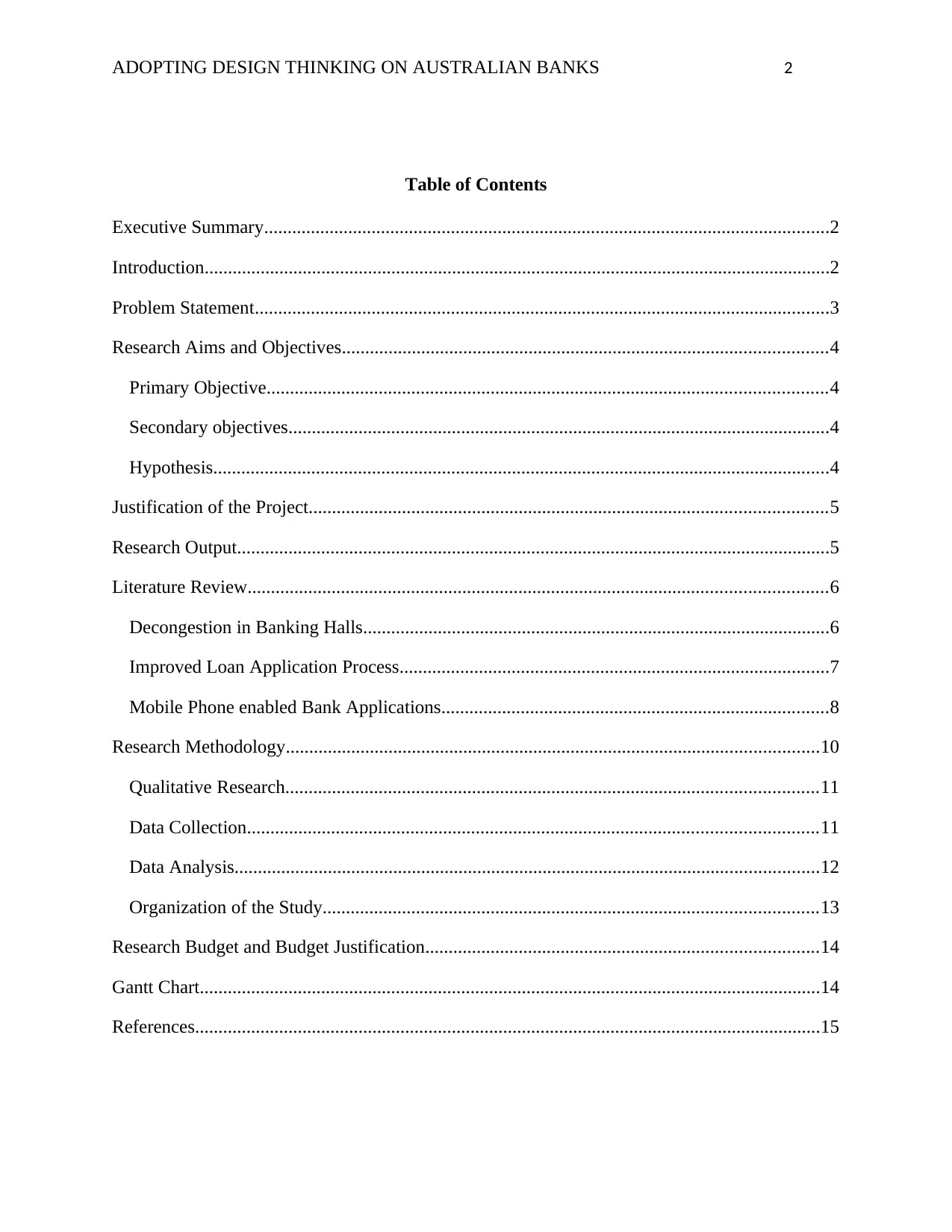
ADOPTING DESIGN THINKING ON AUSTRALIAN BANKS 2
Table of Contents
Executive Summary.........................................................................................................................2
Introduction......................................................................................................................................2
Problem Statement...........................................................................................................................3
Research Aims and Objectives........................................................................................................4
Primary Objective........................................................................................................................4
Secondary objectives....................................................................................................................4
Hypothesis....................................................................................................................................4
Justification of the Project...............................................................................................................5
Research Output...............................................................................................................................5
Literature Review............................................................................................................................6
Decongestion in Banking Halls....................................................................................................6
Improved Loan Application Process............................................................................................7
Mobile Phone enabled Bank Applications...................................................................................8
Research Methodology..................................................................................................................10
Qualitative Research..................................................................................................................11
Data Collection..........................................................................................................................11
Data Analysis.............................................................................................................................12
Organization of the Study..........................................................................................................13
Research Budget and Budget Justification....................................................................................14
Gantt Chart.....................................................................................................................................14
References......................................................................................................................................15
Table of Contents
Executive Summary.........................................................................................................................2
Introduction......................................................................................................................................2
Problem Statement...........................................................................................................................3
Research Aims and Objectives........................................................................................................4
Primary Objective........................................................................................................................4
Secondary objectives....................................................................................................................4
Hypothesis....................................................................................................................................4
Justification of the Project...............................................................................................................5
Research Output...............................................................................................................................5
Literature Review............................................................................................................................6
Decongestion in Banking Halls....................................................................................................6
Improved Loan Application Process............................................................................................7
Mobile Phone enabled Bank Applications...................................................................................8
Research Methodology..................................................................................................................10
Qualitative Research..................................................................................................................11
Data Collection..........................................................................................................................11
Data Analysis.............................................................................................................................12
Organization of the Study..........................................................................................................13
Research Budget and Budget Justification....................................................................................14
Gantt Chart.....................................................................................................................................14
References......................................................................................................................................15
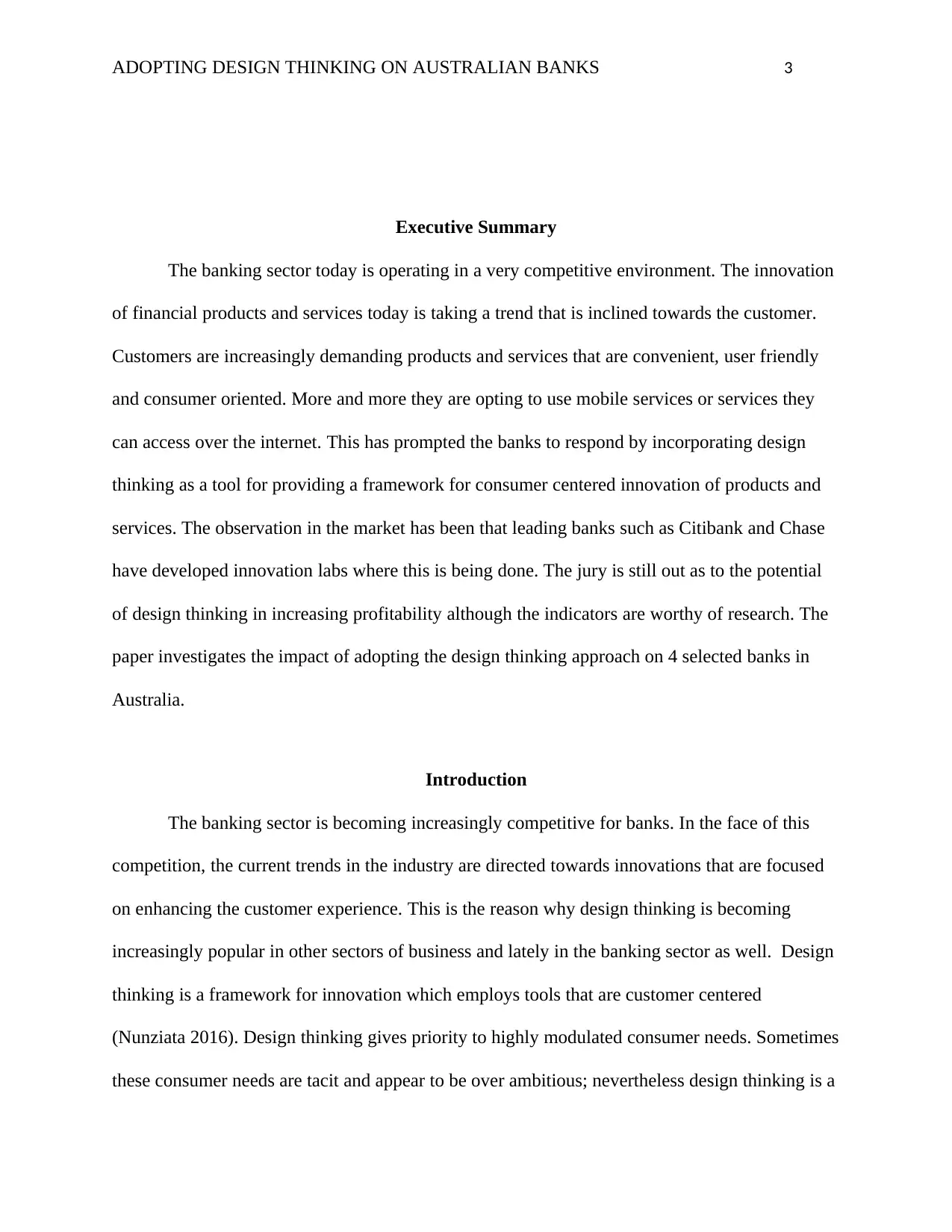
ADOPTING DESIGN THINKING ON AUSTRALIAN BANKS 3
Executive Summary
The banking sector today is operating in a very competitive environment. The innovation
of financial products and services today is taking a trend that is inclined towards the customer.
Customers are increasingly demanding products and services that are convenient, user friendly
and consumer oriented. More and more they are opting to use mobile services or services they
can access over the internet. This has prompted the banks to respond by incorporating design
thinking as a tool for providing a framework for consumer centered innovation of products and
services. The observation in the market has been that leading banks such as Citibank and Chase
have developed innovation labs where this is being done. The jury is still out as to the potential
of design thinking in increasing profitability although the indicators are worthy of research. The
paper investigates the impact of adopting the design thinking approach on 4 selected banks in
Australia.
Introduction
The banking sector is becoming increasingly competitive for banks. In the face of this
competition, the current trends in the industry are directed towards innovations that are focused
on enhancing the customer experience. This is the reason why design thinking is becoming
increasingly popular in other sectors of business and lately in the banking sector as well. Design
thinking is a framework for innovation which employs tools that are customer centered
(Nunziata 2016). Design thinking gives priority to highly modulated consumer needs. Sometimes
these consumer needs are tacit and appear to be over ambitious; nevertheless design thinking is a
Executive Summary
The banking sector today is operating in a very competitive environment. The innovation
of financial products and services today is taking a trend that is inclined towards the customer.
Customers are increasingly demanding products and services that are convenient, user friendly
and consumer oriented. More and more they are opting to use mobile services or services they
can access over the internet. This has prompted the banks to respond by incorporating design
thinking as a tool for providing a framework for consumer centered innovation of products and
services. The observation in the market has been that leading banks such as Citibank and Chase
have developed innovation labs where this is being done. The jury is still out as to the potential
of design thinking in increasing profitability although the indicators are worthy of research. The
paper investigates the impact of adopting the design thinking approach on 4 selected banks in
Australia.
Introduction
The banking sector is becoming increasingly competitive for banks. In the face of this
competition, the current trends in the industry are directed towards innovations that are focused
on enhancing the customer experience. This is the reason why design thinking is becoming
increasingly popular in other sectors of business and lately in the banking sector as well. Design
thinking is a framework for innovation which employs tools that are customer centered
(Nunziata 2016). Design thinking gives priority to highly modulated consumer needs. Sometimes
these consumer needs are tacit and appear to be over ambitious; nevertheless design thinking is a
⊘ This is a preview!⊘
Do you want full access?
Subscribe today to unlock all pages.

Trusted by 1+ million students worldwide
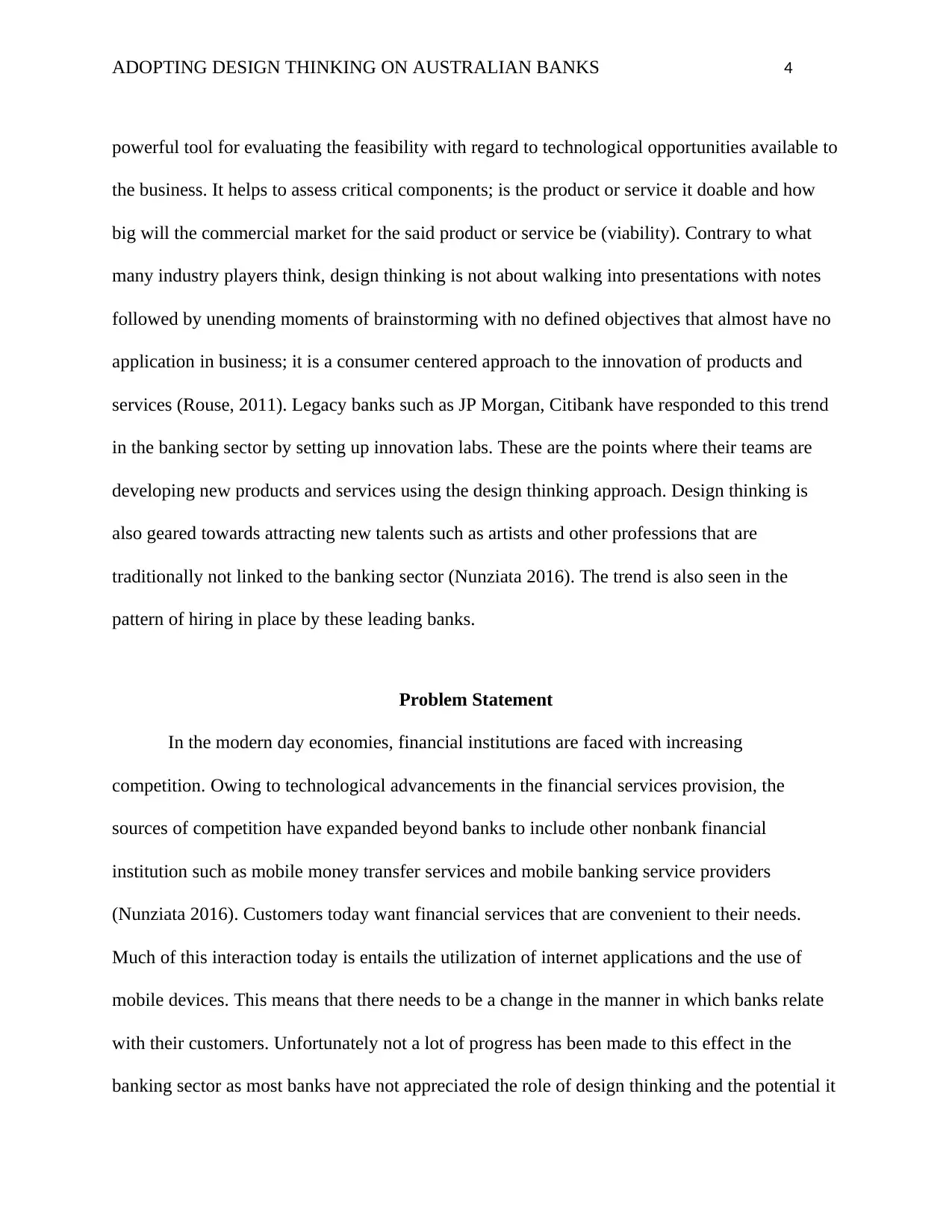
ADOPTING DESIGN THINKING ON AUSTRALIAN BANKS 4
powerful tool for evaluating the feasibility with regard to technological opportunities available to
the business. It helps to assess critical components; is the product or service it doable and how
big will the commercial market for the said product or service be (viability). Contrary to what
many industry players think, design thinking is not about walking into presentations with notes
followed by unending moments of brainstorming with no defined objectives that almost have no
application in business; it is a consumer centered approach to the innovation of products and
services (Rouse, 2011). Legacy banks such as JP Morgan, Citibank have responded to this trend
in the banking sector by setting up innovation labs. These are the points where their teams are
developing new products and services using the design thinking approach. Design thinking is
also geared towards attracting new talents such as artists and other professions that are
traditionally not linked to the banking sector (Nunziata 2016). The trend is also seen in the
pattern of hiring in place by these leading banks.
Problem Statement
In the modern day economies, financial institutions are faced with increasing
competition. Owing to technological advancements in the financial services provision, the
sources of competition have expanded beyond banks to include other nonbank financial
institution such as mobile money transfer services and mobile banking service providers
(Nunziata 2016). Customers today want financial services that are convenient to their needs.
Much of this interaction today is entails the utilization of internet applications and the use of
mobile devices. This means that there needs to be a change in the manner in which banks relate
with their customers. Unfortunately not a lot of progress has been made to this effect in the
banking sector as most banks have not appreciated the role of design thinking and the potential it
powerful tool for evaluating the feasibility with regard to technological opportunities available to
the business. It helps to assess critical components; is the product or service it doable and how
big will the commercial market for the said product or service be (viability). Contrary to what
many industry players think, design thinking is not about walking into presentations with notes
followed by unending moments of brainstorming with no defined objectives that almost have no
application in business; it is a consumer centered approach to the innovation of products and
services (Rouse, 2011). Legacy banks such as JP Morgan, Citibank have responded to this trend
in the banking sector by setting up innovation labs. These are the points where their teams are
developing new products and services using the design thinking approach. Design thinking is
also geared towards attracting new talents such as artists and other professions that are
traditionally not linked to the banking sector (Nunziata 2016). The trend is also seen in the
pattern of hiring in place by these leading banks.
Problem Statement
In the modern day economies, financial institutions are faced with increasing
competition. Owing to technological advancements in the financial services provision, the
sources of competition have expanded beyond banks to include other nonbank financial
institution such as mobile money transfer services and mobile banking service providers
(Nunziata 2016). Customers today want financial services that are convenient to their needs.
Much of this interaction today is entails the utilization of internet applications and the use of
mobile devices. This means that there needs to be a change in the manner in which banks relate
with their customers. Unfortunately not a lot of progress has been made to this effect in the
banking sector as most banks have not appreciated the role of design thinking and the potential it
Paraphrase This Document
Need a fresh take? Get an instant paraphrase of this document with our AI Paraphraser
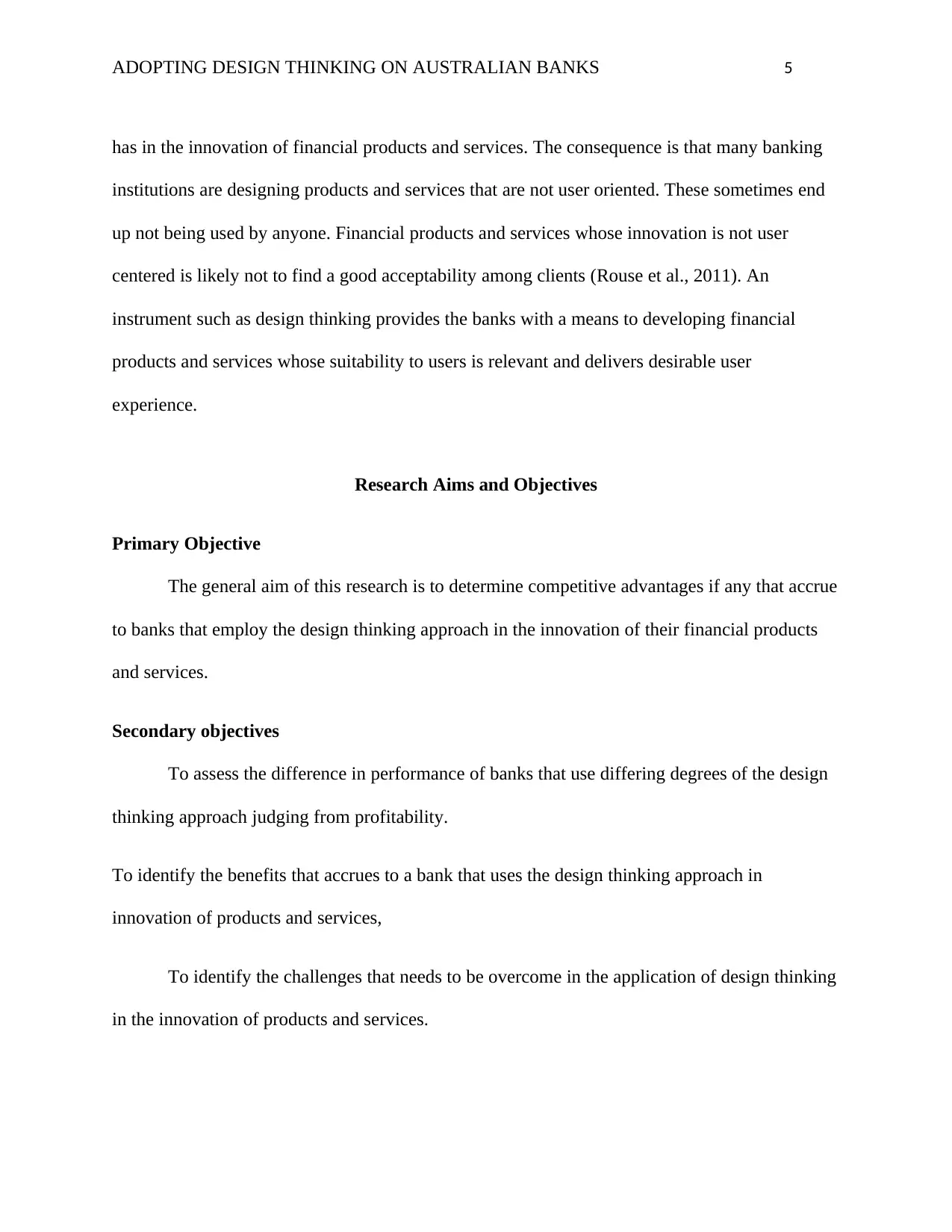
ADOPTING DESIGN THINKING ON AUSTRALIAN BANKS 5
has in the innovation of financial products and services. The consequence is that many banking
institutions are designing products and services that are not user oriented. These sometimes end
up not being used by anyone. Financial products and services whose innovation is not user
centered is likely not to find a good acceptability among clients (Rouse et al., 2011). An
instrument such as design thinking provides the banks with a means to developing financial
products and services whose suitability to users is relevant and delivers desirable user
experience.
Research Aims and Objectives
Primary Objective
The general aim of this research is to determine competitive advantages if any that accrue
to banks that employ the design thinking approach in the innovation of their financial products
and services.
Secondary objectives
To assess the difference in performance of banks that use differing degrees of the design
thinking approach judging from profitability.
To identify the benefits that accrues to a bank that uses the design thinking approach in
innovation of products and services,
To identify the challenges that needs to be overcome in the application of design thinking
in the innovation of products and services.
has in the innovation of financial products and services. The consequence is that many banking
institutions are designing products and services that are not user oriented. These sometimes end
up not being used by anyone. Financial products and services whose innovation is not user
centered is likely not to find a good acceptability among clients (Rouse et al., 2011). An
instrument such as design thinking provides the banks with a means to developing financial
products and services whose suitability to users is relevant and delivers desirable user
experience.
Research Aims and Objectives
Primary Objective
The general aim of this research is to determine competitive advantages if any that accrue
to banks that employ the design thinking approach in the innovation of their financial products
and services.
Secondary objectives
To assess the difference in performance of banks that use differing degrees of the design
thinking approach judging from profitability.
To identify the benefits that accrues to a bank that uses the design thinking approach in
innovation of products and services,
To identify the challenges that needs to be overcome in the application of design thinking
in the innovation of products and services.
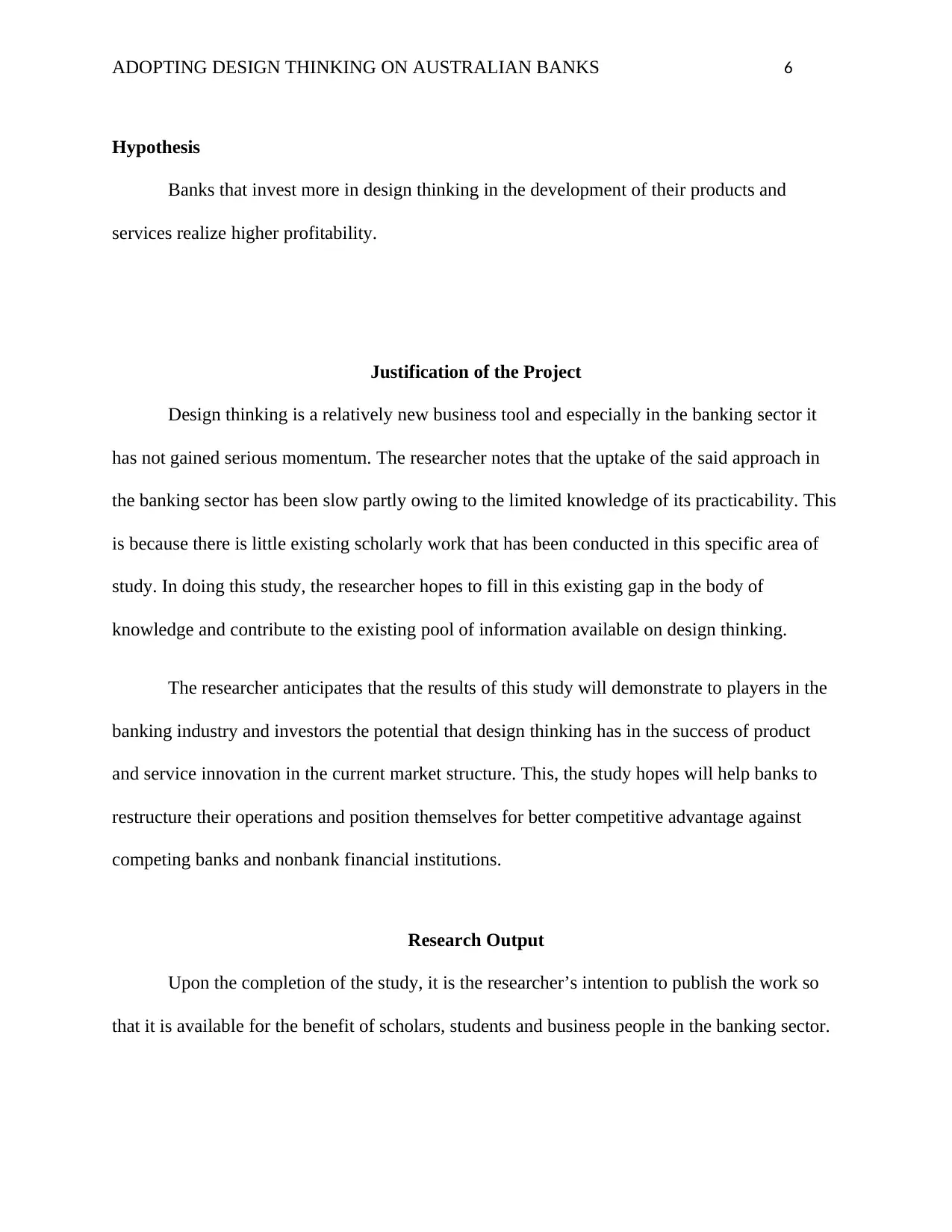
ADOPTING DESIGN THINKING ON AUSTRALIAN BANKS 6
Hypothesis
Banks that invest more in design thinking in the development of their products and
services realize higher profitability.
Justification of the Project
Design thinking is a relatively new business tool and especially in the banking sector it
has not gained serious momentum. The researcher notes that the uptake of the said approach in
the banking sector has been slow partly owing to the limited knowledge of its practicability. This
is because there is little existing scholarly work that has been conducted in this specific area of
study. In doing this study, the researcher hopes to fill in this existing gap in the body of
knowledge and contribute to the existing pool of information available on design thinking.
The researcher anticipates that the results of this study will demonstrate to players in the
banking industry and investors the potential that design thinking has in the success of product
and service innovation in the current market structure. This, the study hopes will help banks to
restructure their operations and position themselves for better competitive advantage against
competing banks and nonbank financial institutions.
Research Output
Upon the completion of the study, it is the researcher’s intention to publish the work so
that it is available for the benefit of scholars, students and business people in the banking sector.
Hypothesis
Banks that invest more in design thinking in the development of their products and
services realize higher profitability.
Justification of the Project
Design thinking is a relatively new business tool and especially in the banking sector it
has not gained serious momentum. The researcher notes that the uptake of the said approach in
the banking sector has been slow partly owing to the limited knowledge of its practicability. This
is because there is little existing scholarly work that has been conducted in this specific area of
study. In doing this study, the researcher hopes to fill in this existing gap in the body of
knowledge and contribute to the existing pool of information available on design thinking.
The researcher anticipates that the results of this study will demonstrate to players in the
banking industry and investors the potential that design thinking has in the success of product
and service innovation in the current market structure. This, the study hopes will help banks to
restructure their operations and position themselves for better competitive advantage against
competing banks and nonbank financial institutions.
Research Output
Upon the completion of the study, it is the researcher’s intention to publish the work so
that it is available for the benefit of scholars, students and business people in the banking sector.
⊘ This is a preview!⊘
Do you want full access?
Subscribe today to unlock all pages.

Trusted by 1+ million students worldwide
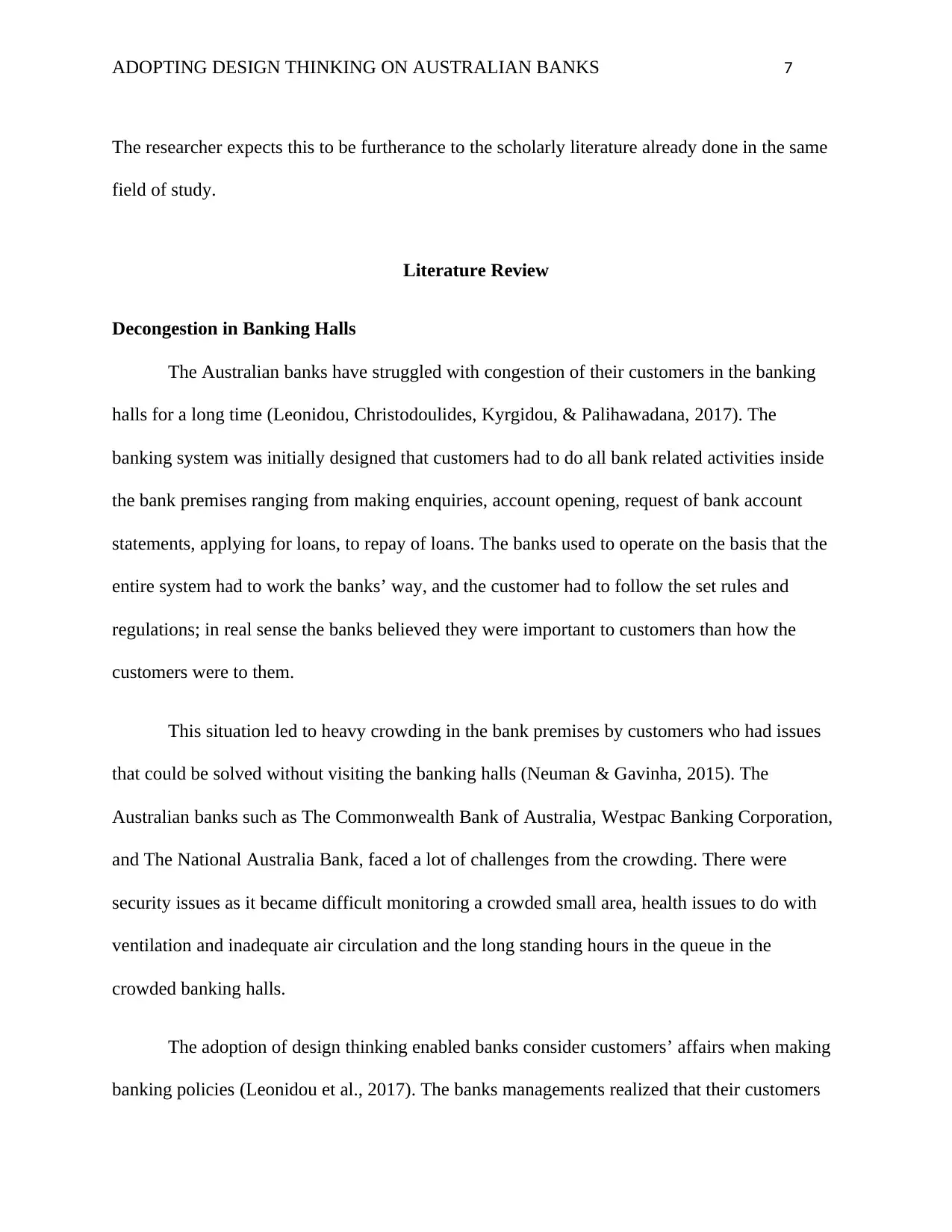
ADOPTING DESIGN THINKING ON AUSTRALIAN BANKS 7
The researcher expects this to be furtherance to the scholarly literature already done in the same
field of study.
Literature Review
Decongestion in Banking Halls
The Australian banks have struggled with congestion of their customers in the banking
halls for a long time (Leonidou, Christodoulides, Kyrgidou, & Palihawadana, 2017). The
banking system was initially designed that customers had to do all bank related activities inside
the bank premises ranging from making enquiries, account opening, request of bank account
statements, applying for loans, to repay of loans. The banks used to operate on the basis that the
entire system had to work the banks’ way, and the customer had to follow the set rules and
regulations; in real sense the banks believed they were important to customers than how the
customers were to them.
This situation led to heavy crowding in the bank premises by customers who had issues
that could be solved without visiting the banking halls (Neuman & Gavinha, 2015). The
Australian banks such as The Commonwealth Bank of Australia, Westpac Banking Corporation,
and The National Australia Bank, faced a lot of challenges from the crowding. There were
security issues as it became difficult monitoring a crowded small area, health issues to do with
ventilation and inadequate air circulation and the long standing hours in the queue in the
crowded banking halls.
The adoption of design thinking enabled banks consider customers’ affairs when making
banking policies (Leonidou et al., 2017). The banks managements realized that their customers
The researcher expects this to be furtherance to the scholarly literature already done in the same
field of study.
Literature Review
Decongestion in Banking Halls
The Australian banks have struggled with congestion of their customers in the banking
halls for a long time (Leonidou, Christodoulides, Kyrgidou, & Palihawadana, 2017). The
banking system was initially designed that customers had to do all bank related activities inside
the bank premises ranging from making enquiries, account opening, request of bank account
statements, applying for loans, to repay of loans. The banks used to operate on the basis that the
entire system had to work the banks’ way, and the customer had to follow the set rules and
regulations; in real sense the banks believed they were important to customers than how the
customers were to them.
This situation led to heavy crowding in the bank premises by customers who had issues
that could be solved without visiting the banking halls (Neuman & Gavinha, 2015). The
Australian banks such as The Commonwealth Bank of Australia, Westpac Banking Corporation,
and The National Australia Bank, faced a lot of challenges from the crowding. There were
security issues as it became difficult monitoring a crowded small area, health issues to do with
ventilation and inadequate air circulation and the long standing hours in the queue in the
crowded banking halls.
The adoption of design thinking enabled banks consider customers’ affairs when making
banking policies (Leonidou et al., 2017). The banks managements realized that their customers
Paraphrase This Document
Need a fresh take? Get an instant paraphrase of this document with our AI Paraphraser

ADOPTING DESIGN THINKING ON AUSTRALIAN BANKS 8
did not deserve the long queues to request small services like just making an enquiry about some
types of accounts. Design Thinking enabled the banks adjust their strategies and activated some
services online like making enquiries, opening bank accounts, and requesting for statements that
are nowadays emailed to customer. With these improvements through Design Thinking, the
banking halls are presentable as there are no customer crowding. The reduced congestion has
enable banks to improve the quality of their services as they have enough time to attend to the
few customers who visit the banking halls with serious issues (Read & Sanderford, 2018). The
banks have been even able to reduce the space occupied by banking hall, a fact that has reduced
operation costs and increase income to banks that rent out the excess space to other firms.
Improved Loan Application Process
Before the adoption of Design Thinking in banking industry, most banks in Australia
would design bank loans on the basis of how much they would earn as interests and other
charges without taking the loanee into account (Beung & Snell, 2017). The loan term and interest
calculations were mostly meant to favor the financial institution, the loan applicant had to adjust
his or her plan if it did coincide with the financier’s set policies, terms and conditions. Loan
application procedures used to be complex, confusing clients in the process making them end up
signing terms that they did not fully understand.
The strict loan policies caused a lot of inconvenience too many customers who
sometimes had to surrender their applications hence forfeiting their dream projects (Kaur Sahi,
Sehgal, & Sharma, 2017). Signing of loan terms without fully understanding caused many
challenges during loan repayment phase, leading to auctioning of their hard earned properties.
did not deserve the long queues to request small services like just making an enquiry about some
types of accounts. Design Thinking enabled the banks adjust their strategies and activated some
services online like making enquiries, opening bank accounts, and requesting for statements that
are nowadays emailed to customer. With these improvements through Design Thinking, the
banking halls are presentable as there are no customer crowding. The reduced congestion has
enable banks to improve the quality of their services as they have enough time to attend to the
few customers who visit the banking halls with serious issues (Read & Sanderford, 2018). The
banks have been even able to reduce the space occupied by banking hall, a fact that has reduced
operation costs and increase income to banks that rent out the excess space to other firms.
Improved Loan Application Process
Before the adoption of Design Thinking in banking industry, most banks in Australia
would design bank loans on the basis of how much they would earn as interests and other
charges without taking the loanee into account (Beung & Snell, 2017). The loan term and interest
calculations were mostly meant to favor the financial institution, the loan applicant had to adjust
his or her plan if it did coincide with the financier’s set policies, terms and conditions. Loan
application procedures used to be complex, confusing clients in the process making them end up
signing terms that they did not fully understand.
The strict loan policies caused a lot of inconvenience too many customers who
sometimes had to surrender their applications hence forfeiting their dream projects (Kaur Sahi,
Sehgal, & Sharma, 2017). Signing of loan terms without fully understanding caused many
challenges during loan repayment phase, leading to auctioning of their hard earned properties.
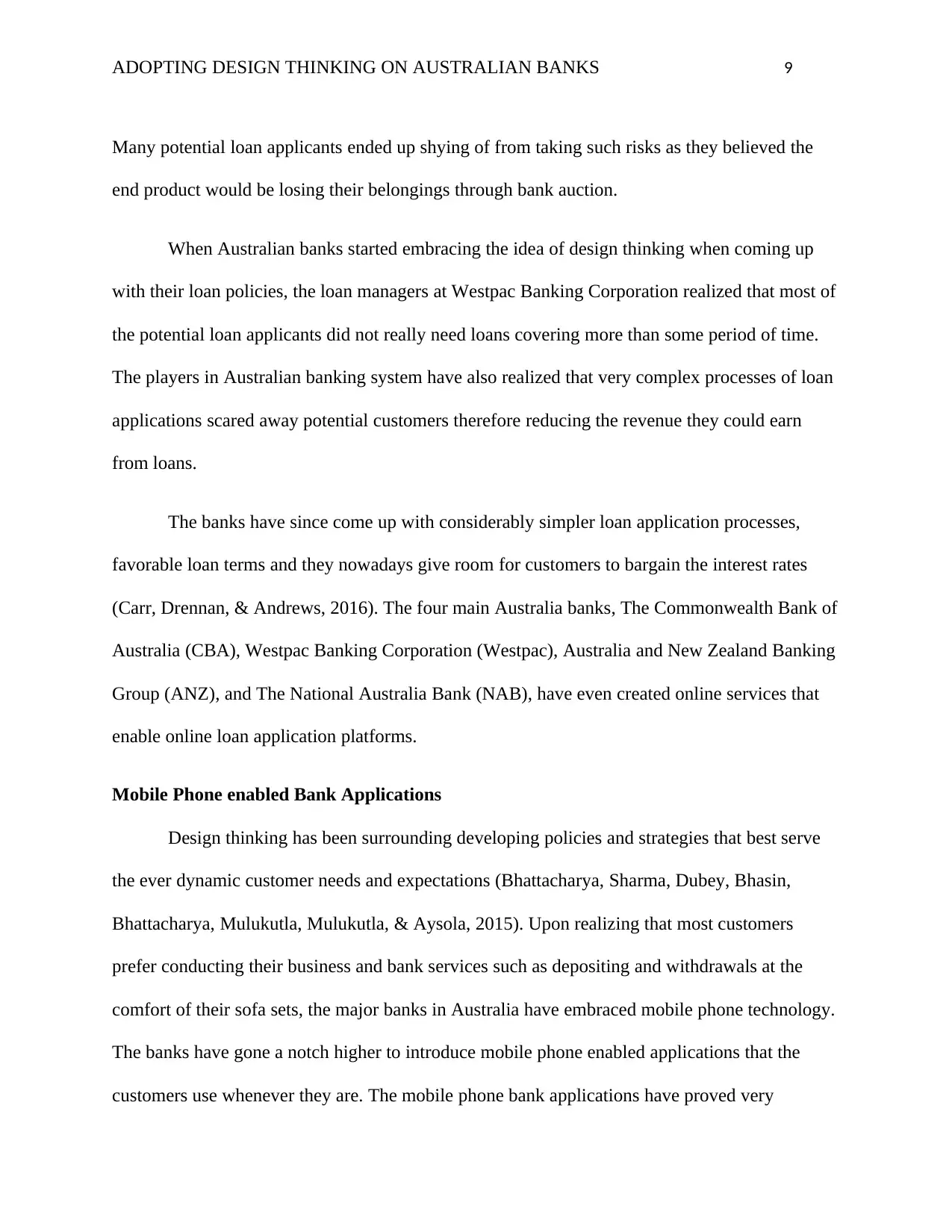
ADOPTING DESIGN THINKING ON AUSTRALIAN BANKS 9
Many potential loan applicants ended up shying of from taking such risks as they believed the
end product would be losing their belongings through bank auction.
When Australian banks started embracing the idea of design thinking when coming up
with their loan policies, the loan managers at Westpac Banking Corporation realized that most of
the potential loan applicants did not really need loans covering more than some period of time.
The players in Australian banking system have also realized that very complex processes of loan
applications scared away potential customers therefore reducing the revenue they could earn
from loans.
The banks have since come up with considerably simpler loan application processes,
favorable loan terms and they nowadays give room for customers to bargain the interest rates
(Carr, Drennan, & Andrews, 2016). The four main Australia banks, The Commonwealth Bank of
Australia (CBA), Westpac Banking Corporation (Westpac), Australia and New Zealand Banking
Group (ANZ), and The National Australia Bank (NAB), have even created online services that
enable online loan application platforms.
Mobile Phone enabled Bank Applications
Design thinking has been surrounding developing policies and strategies that best serve
the ever dynamic customer needs and expectations (Bhattacharya, Sharma, Dubey, Bhasin,
Bhattacharya, Mulukutla, Mulukutla, & Aysola, 2015). Upon realizing that most customers
prefer conducting their business and bank services such as depositing and withdrawals at the
comfort of their sofa sets, the major banks in Australia have embraced mobile phone technology.
The banks have gone a notch higher to introduce mobile phone enabled applications that the
customers use whenever they are. The mobile phone bank applications have proved very
Many potential loan applicants ended up shying of from taking such risks as they believed the
end product would be losing their belongings through bank auction.
When Australian banks started embracing the idea of design thinking when coming up
with their loan policies, the loan managers at Westpac Banking Corporation realized that most of
the potential loan applicants did not really need loans covering more than some period of time.
The players in Australian banking system have also realized that very complex processes of loan
applications scared away potential customers therefore reducing the revenue they could earn
from loans.
The banks have since come up with considerably simpler loan application processes,
favorable loan terms and they nowadays give room for customers to bargain the interest rates
(Carr, Drennan, & Andrews, 2016). The four main Australia banks, The Commonwealth Bank of
Australia (CBA), Westpac Banking Corporation (Westpac), Australia and New Zealand Banking
Group (ANZ), and The National Australia Bank (NAB), have even created online services that
enable online loan application platforms.
Mobile Phone enabled Bank Applications
Design thinking has been surrounding developing policies and strategies that best serve
the ever dynamic customer needs and expectations (Bhattacharya, Sharma, Dubey, Bhasin,
Bhattacharya, Mulukutla, Mulukutla, & Aysola, 2015). Upon realizing that most customers
prefer conducting their business and bank services such as depositing and withdrawals at the
comfort of their sofa sets, the major banks in Australia have embraced mobile phone technology.
The banks have gone a notch higher to introduce mobile phone enabled applications that the
customers use whenever they are. The mobile phone bank applications have proved very
⊘ This is a preview!⊘
Do you want full access?
Subscribe today to unlock all pages.

Trusted by 1+ million students worldwide
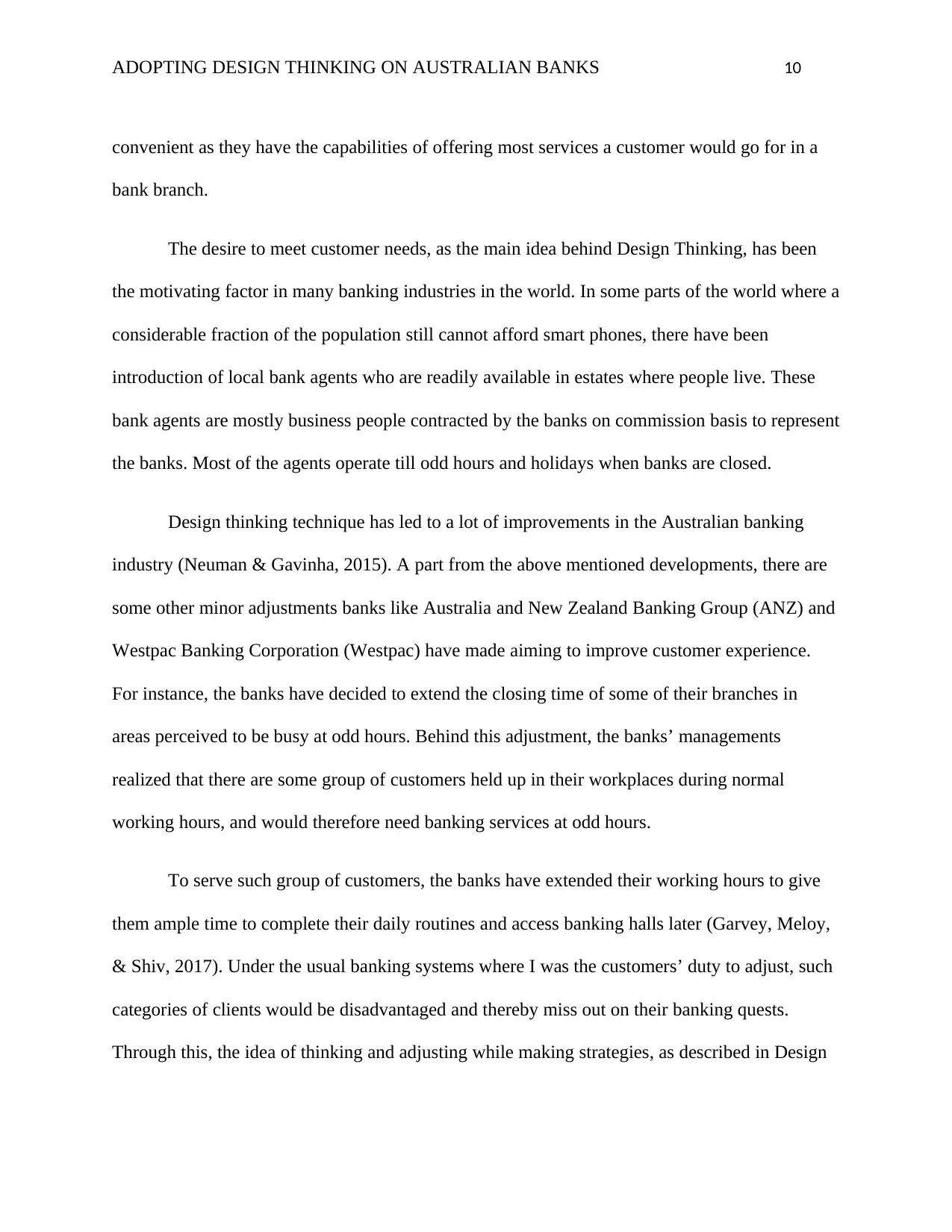
ADOPTING DESIGN THINKING ON AUSTRALIAN BANKS 10
convenient as they have the capabilities of offering most services a customer would go for in a
bank branch.
The desire to meet customer needs, as the main idea behind Design Thinking, has been
the motivating factor in many banking industries in the world. In some parts of the world where a
considerable fraction of the population still cannot afford smart phones, there have been
introduction of local bank agents who are readily available in estates where people live. These
bank agents are mostly business people contracted by the banks on commission basis to represent
the banks. Most of the agents operate till odd hours and holidays when banks are closed.
Design thinking technique has led to a lot of improvements in the Australian banking
industry (Neuman & Gavinha, 2015). A part from the above mentioned developments, there are
some other minor adjustments banks like Australia and New Zealand Banking Group (ANZ) and
Westpac Banking Corporation (Westpac) have made aiming to improve customer experience.
For instance, the banks have decided to extend the closing time of some of their branches in
areas perceived to be busy at odd hours. Behind this adjustment, the banks’ managements
realized that there are some group of customers held up in their workplaces during normal
working hours, and would therefore need banking services at odd hours.
To serve such group of customers, the banks have extended their working hours to give
them ample time to complete their daily routines and access banking halls later (Garvey, Meloy,
& Shiv, 2017). Under the usual banking systems where I was the customers’ duty to adjust, such
categories of clients would be disadvantaged and thereby miss out on their banking quests.
Through this, the idea of thinking and adjusting while making strategies, as described in Design
convenient as they have the capabilities of offering most services a customer would go for in a
bank branch.
The desire to meet customer needs, as the main idea behind Design Thinking, has been
the motivating factor in many banking industries in the world. In some parts of the world where a
considerable fraction of the population still cannot afford smart phones, there have been
introduction of local bank agents who are readily available in estates where people live. These
bank agents are mostly business people contracted by the banks on commission basis to represent
the banks. Most of the agents operate till odd hours and holidays when banks are closed.
Design thinking technique has led to a lot of improvements in the Australian banking
industry (Neuman & Gavinha, 2015). A part from the above mentioned developments, there are
some other minor adjustments banks like Australia and New Zealand Banking Group (ANZ) and
Westpac Banking Corporation (Westpac) have made aiming to improve customer experience.
For instance, the banks have decided to extend the closing time of some of their branches in
areas perceived to be busy at odd hours. Behind this adjustment, the banks’ managements
realized that there are some group of customers held up in their workplaces during normal
working hours, and would therefore need banking services at odd hours.
To serve such group of customers, the banks have extended their working hours to give
them ample time to complete their daily routines and access banking halls later (Garvey, Meloy,
& Shiv, 2017). Under the usual banking systems where I was the customers’ duty to adjust, such
categories of clients would be disadvantaged and thereby miss out on their banking quests.
Through this, the idea of thinking and adjusting while making strategies, as described in Design
Paraphrase This Document
Need a fresh take? Get an instant paraphrase of this document with our AI Paraphraser
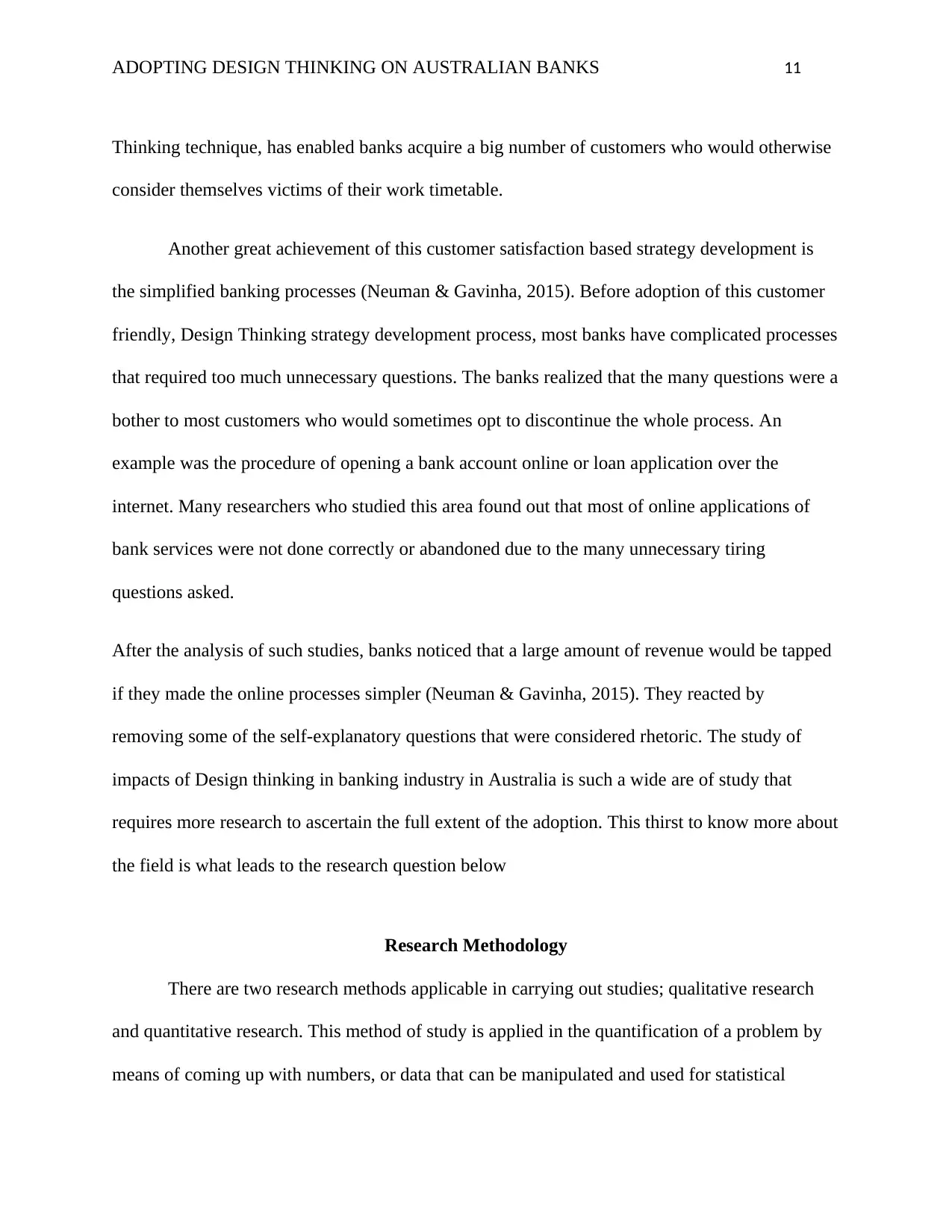
ADOPTING DESIGN THINKING ON AUSTRALIAN BANKS 11
Thinking technique, has enabled banks acquire a big number of customers who would otherwise
consider themselves victims of their work timetable.
Another great achievement of this customer satisfaction based strategy development is
the simplified banking processes (Neuman & Gavinha, 2015). Before adoption of this customer
friendly, Design Thinking strategy development process, most banks have complicated processes
that required too much unnecessary questions. The banks realized that the many questions were a
bother to most customers who would sometimes opt to discontinue the whole process. An
example was the procedure of opening a bank account online or loan application over the
internet. Many researchers who studied this area found out that most of online applications of
bank services were not done correctly or abandoned due to the many unnecessary tiring
questions asked.
After the analysis of such studies, banks noticed that a large amount of revenue would be tapped
if they made the online processes simpler (Neuman & Gavinha, 2015). They reacted by
removing some of the self-explanatory questions that were considered rhetoric. The study of
impacts of Design thinking in banking industry in Australia is such a wide are of study that
requires more research to ascertain the full extent of the adoption. This thirst to know more about
the field is what leads to the research question below
Research Methodology
There are two research methods applicable in carrying out studies; qualitative research
and quantitative research. This method of study is applied in the quantification of a problem by
means of coming up with numbers, or data that can be manipulated and used for statistical
Thinking technique, has enabled banks acquire a big number of customers who would otherwise
consider themselves victims of their work timetable.
Another great achievement of this customer satisfaction based strategy development is
the simplified banking processes (Neuman & Gavinha, 2015). Before adoption of this customer
friendly, Design Thinking strategy development process, most banks have complicated processes
that required too much unnecessary questions. The banks realized that the many questions were a
bother to most customers who would sometimes opt to discontinue the whole process. An
example was the procedure of opening a bank account online or loan application over the
internet. Many researchers who studied this area found out that most of online applications of
bank services were not done correctly or abandoned due to the many unnecessary tiring
questions asked.
After the analysis of such studies, banks noticed that a large amount of revenue would be tapped
if they made the online processes simpler (Neuman & Gavinha, 2015). They reacted by
removing some of the self-explanatory questions that were considered rhetoric. The study of
impacts of Design thinking in banking industry in Australia is such a wide are of study that
requires more research to ascertain the full extent of the adoption. This thirst to know more about
the field is what leads to the research question below
Research Methodology
There are two research methods applicable in carrying out studies; qualitative research
and quantitative research. This method of study is applied in the quantification of a problem by
means of coming up with numbers, or data that can be manipulated and used for statistical
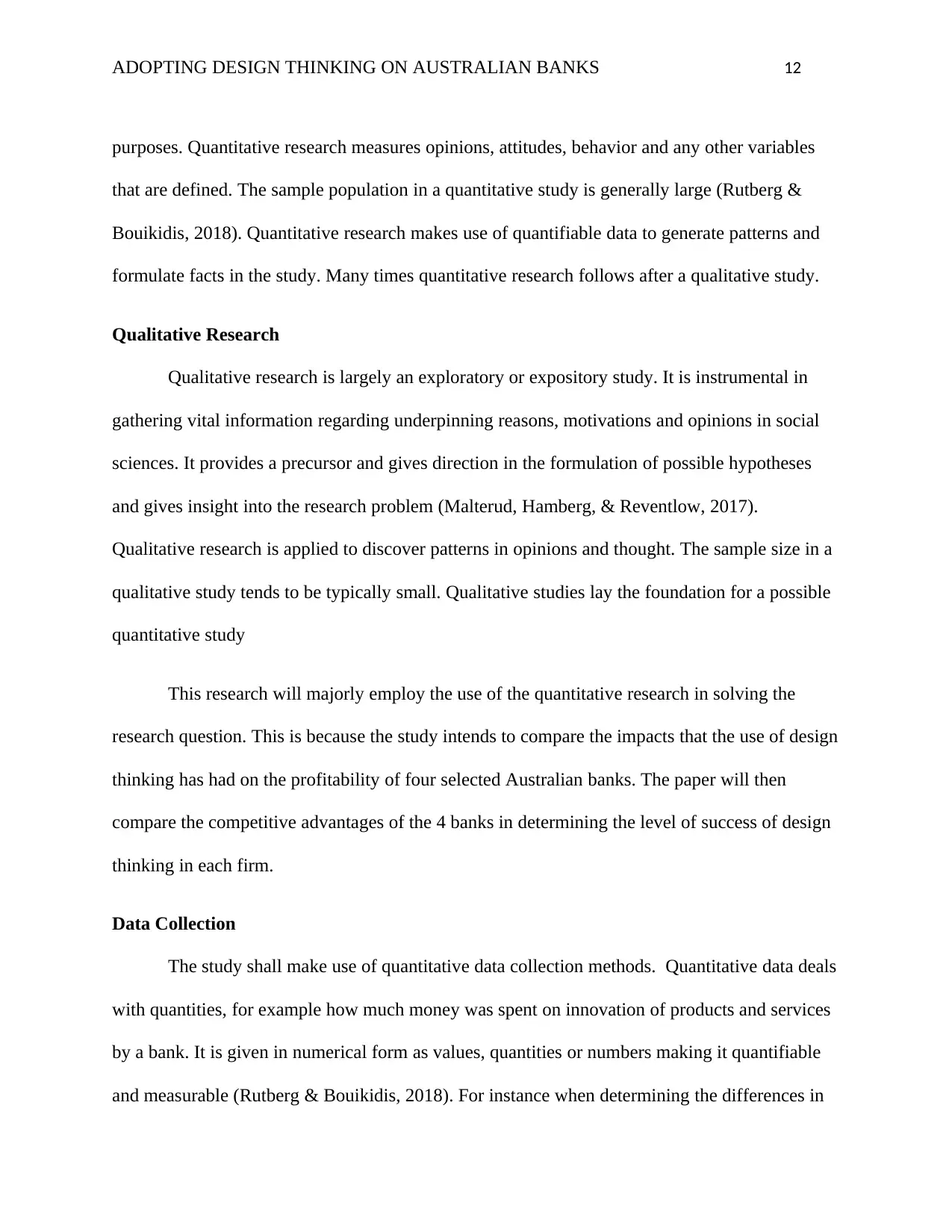
ADOPTING DESIGN THINKING ON AUSTRALIAN BANKS 12
purposes. Quantitative research measures opinions, attitudes, behavior and any other variables
that are defined. The sample population in a quantitative study is generally large (Rutberg &
Bouikidis, 2018). Quantitative research makes use of quantifiable data to generate patterns and
formulate facts in the study. Many times quantitative research follows after a qualitative study.
Qualitative Research
Qualitative research is largely an exploratory or expository study. It is instrumental in
gathering vital information regarding underpinning reasons, motivations and opinions in social
sciences. It provides a precursor and gives direction in the formulation of possible hypotheses
and gives insight into the research problem (Malterud, Hamberg, & Reventlow, 2017).
Qualitative research is applied to discover patterns in opinions and thought. The sample size in a
qualitative study tends to be typically small. Qualitative studies lay the foundation for a possible
quantitative study
This research will majorly employ the use of the quantitative research in solving the
research question. This is because the study intends to compare the impacts that the use of design
thinking has had on the profitability of four selected Australian banks. The paper will then
compare the competitive advantages of the 4 banks in determining the level of success of design
thinking in each firm.
Data Collection
The study shall make use of quantitative data collection methods. Quantitative data deals
with quantities, for example how much money was spent on innovation of products and services
by a bank. It is given in numerical form as values, quantities or numbers making it quantifiable
and measurable (Rutberg & Bouikidis, 2018). For instance when determining the differences in
purposes. Quantitative research measures opinions, attitudes, behavior and any other variables
that are defined. The sample population in a quantitative study is generally large (Rutberg &
Bouikidis, 2018). Quantitative research makes use of quantifiable data to generate patterns and
formulate facts in the study. Many times quantitative research follows after a qualitative study.
Qualitative Research
Qualitative research is largely an exploratory or expository study. It is instrumental in
gathering vital information regarding underpinning reasons, motivations and opinions in social
sciences. It provides a precursor and gives direction in the formulation of possible hypotheses
and gives insight into the research problem (Malterud, Hamberg, & Reventlow, 2017).
Qualitative research is applied to discover patterns in opinions and thought. The sample size in a
qualitative study tends to be typically small. Qualitative studies lay the foundation for a possible
quantitative study
This research will majorly employ the use of the quantitative research in solving the
research question. This is because the study intends to compare the impacts that the use of design
thinking has had on the profitability of four selected Australian banks. The paper will then
compare the competitive advantages of the 4 banks in determining the level of success of design
thinking in each firm.
Data Collection
The study shall make use of quantitative data collection methods. Quantitative data deals
with quantities, for example how much money was spent on innovation of products and services
by a bank. It is given in numerical form as values, quantities or numbers making it quantifiable
and measurable (Rutberg & Bouikidis, 2018). For instance when determining the differences in
⊘ This is a preview!⊘
Do you want full access?
Subscribe today to unlock all pages.

Trusted by 1+ million students worldwide
1 out of 19
Related Documents
Your All-in-One AI-Powered Toolkit for Academic Success.
+13062052269
info@desklib.com
Available 24*7 on WhatsApp / Email
![[object Object]](/_next/static/media/star-bottom.7253800d.svg)
Unlock your academic potential
Copyright © 2020–2025 A2Z Services. All Rights Reserved. Developed and managed by ZUCOL.





